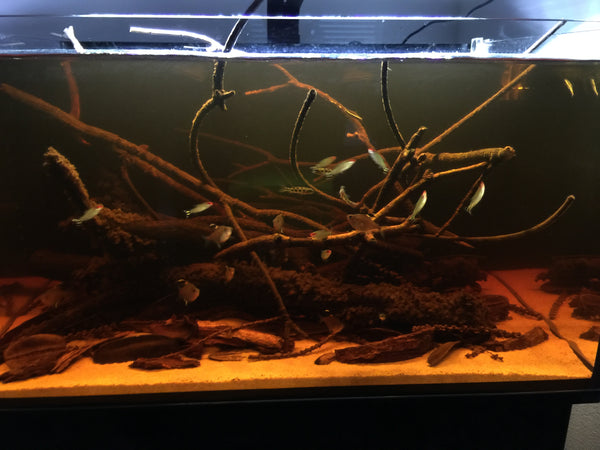- Continue Shopping
- Your Cart is Empty
Beauty beneath the surface- the "functional aesthetics" of the flooded forests...
I admit it.
I'm not the greatest aquascaper in the world. But I do know what I like a certain look. And that look tends to be the seemingly "disorganized", yet remarkably beautiful flooded forests. I find them utterly fascinating and compelling, not only for the way they look, but for the remarkable aggregation of life there.

In this world of decomposing leaves, submerged logs, twigs, and seed pods, there is a surprising diversity of life forms which call this milieu home. And each one of these organisms has manages to eke out an existence and thrive.
A lot of hobbyists not familiar with our aesthetic tastes will ask what the fascination is with throwing palm fronds and seed pods into our tanks, and I tell them that it's a direct inspiration from nature! Sure, the look is quite different than what has been proffered as "natural" in recent years- but I'd guarantee that, if you donned a snorkel and waded into one of these habitats, you'd understand exactly what we are trying to represent in our aquariums in seconds!
We also happen to like the way it looks, of course!
And yeah, tossing in terrestrial palm leaves and palm fronds is spot-on with this habitat.
Ahh, palm fronds.
They've become one of the most popular botanical items we sell, and for good reason. Not only do they represent this habitat so well- they provide an aesthetic component that is radically different than what has been presented in aquariums over the years. And, as they break down, they function exactly as they do in nature, harboring microorganisms and imparting organic materials into the water.
Mauritia flexuosa, the "Moriche Palm", is a species of palm tree which is found commonly in the flooded forests of Amazonia, and unlike many other trees in this habitat, does not require a dry period in order to survive. Rather, it has adapted to existence in swampy conditions. And in the course of its existence, fronds and other parts of the tree will be blown into the flooded forest floors below by wind and other forces. The materials accumulate, providing food and shelter for the fishes and other organisms which reside there.

(Image by Bernard Dupont, used under CC BY-SA 2.0)
It's a pattern which is not only functional and important to the overall ecosystem- it explains exactly why those of us who like to represent this habitat "throw in" seed pods, plant parts, twigs, etc. into our aquascapes. It is an accurate, if not nuanced- simulation of what occurs in nature.

And of course, nothing is ever wasted in nature.

Fishes commonly feed on the fruits and nuts knocked down from overhanging trees by various animals which reside in the forest canopy, such as birds and monkeys. The primary "fruit-eaters" of the flooded forests are characins and catfishes. Obviously, the larger specimens can consume many fruits whole, whereas the smaller guys we tend to play with will pick at the fruits that cannot fit easily into their smaller mouths.

So, an aquarium simulation of a flooded forest would simply not be complete if it didn't include at least some palm fronds and some nice thin branches to simulate this complex aggregation of materials. And of course- the leaves and seed pods which we find so intriguing are an integral part of this habitat as well.

And of course, these habitats harbor insects- lots of 'em...and the smaller fishes are voracious consumers of them. Insects such as beetles, ants and spiders make up the largest part of the insectivores' diets in this habitat. It's though that these "bugs" end up I the water because of population density in the tree canopy, as well as the action of wind and rain...And the fishes instinctively know this, and accumulate in this habitat in great numbers.

Interestingly, it's been postulated by biologists that smaller fishes are more adept at catching and consuming the small insects that fall into these waters- a good explanation for the abundance of them in this unique habitat. And a good reason to include lots of smaller Tetras in your flooded forest replication!
These compelling habitats, and the botanical components which contribute to them, are an endless source of fascination, education, and inspiration for us. Perhaps the key to understanding their function in the wild is to recreate-to some extent- their appearance and function in our aquariums.

And it's that desire to know, to comprehend- and to appreciate their intricate, if not seemingly random beauty, which keeps us flirting with the flooded forests.
Stay intrigued. Stay creative. Stay open-minded. Stay fasciated...
And Stay Wet.
Scott Fellman
Tannin Aquatics









Scott Fellman
Author